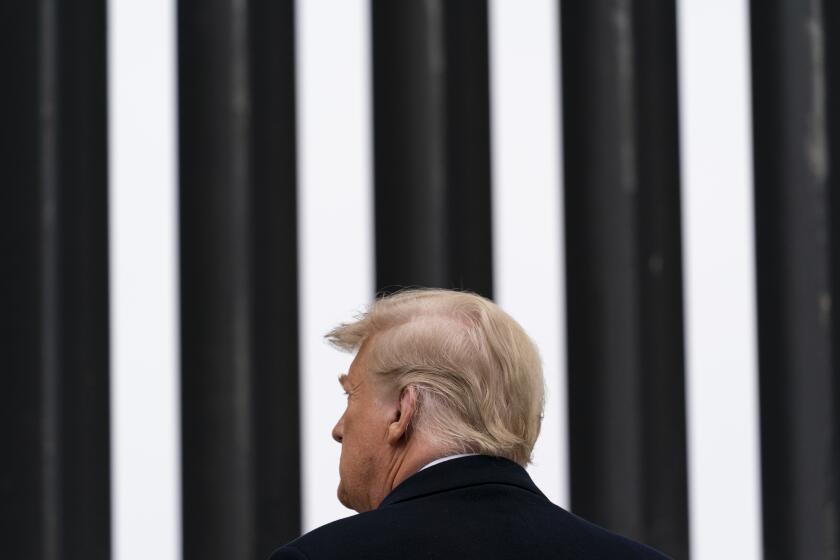‘Cash for clunkers’: a clunker?
- Share via
Today’s topic: Is “cash for clunkers” a Keynesian success story, or did it produce nothing more than a blip in car sales?
What good are we doing by destroying the clunkers?
Point: Brad DeLong
I find it hard to imagine that you and I will find much to disagree on today, Ed. Yes, there are lots of unemployed autoworkers who will be doing nothing if we don’t boost auto demand. Yes, it would be good if we had a set of policies that actually gave people the right incentives to buy the right kind of car and drive the right amount -- policies that make people feel in their wallets the cost of global warming and the cost of the fact that because their cars are on I-5, everybody else has to go slower.
I suspect that you and I could immediately get behind a plan to tax gasoline more, issue bonds now to be amortized by the gasoline tax far into the future and return the money to consumers by using the funds from the bonds to give cash back to people who buy high-mileage cars. That would provide a good short-run Keynesian stimulus to get autoworkers back to work; it would also be a good long-run environmental policy. Since it would be budget-neutral (or budget-positive), spend money now and lock in the tax increases to pay off the bonds later, it would be a win-win-win.
But that’s not what “cash for clunkers” is. We are destroying the clunkers, which could be very useful things in Africa or the poorer parts of Latin America or Asia; it would be cheap to load the cars onto some of the idle container ships off Long Beach and send them off. What we’re doing instead is simply a waste. John Maynard Keynes wrote that if you couldn’t think of anything else to do, bury money in holes in the ground so people have an incentive to hire the unemployed to dig it up. That’s much worse than having the government spend money on things that are useful. But it seems better than “cash for clunkers,” which looks to me like the equivalent of breaking windows so we can then put people to work fixing them.
Here I do think that a genuine opportunity has been lost. I don’t think that “cash for clunkers” is positively harmful; the destruction of the clunkers isn’t costing us very much, and that cost is probably offset by the benefit of lowering unemployment a little bit. The program is certainly well-targeted at Michigan, which needs all the help it can get. The blip in car sales is real, and it will serve as a Keynesian stimulus: People will be rehired sooner to rebuild the auto inventories that have been drawn down, and they will then have higher incomes and spend more. The places where they shop will have more sales and hire people who will then have higher incomes, and so on.
But we could have done so much better, as far as environmentally friendly stimulus proposals are concerned. It really does make me cry.
Brad DeLong is a UC Berkeley economics professor who served in the U.S. Treasury Department during the Clinton administration. His blog is “Grasping Reality with Both Hands.”
The unseen effects of bad stimulus spending
Counterpoint: Edward E. Leamer
Brad, we really do agree on this “cash for clunkers” program, which gives me an opportunity to comment on your Wednesday post.
You are scoring some good debating points, but to do so you are misrepresenting my opinions. I said we have some very important and very difficult adjustments to make. I did not say that a recession was the only way to accomplish this task. I once had high hopes that we could make the needed adjustments with an extended period of sluggish growth rather than a recession. Now that we are in a recession, I have explicitly endorsed a well-designed stimulus package to make things better. Where we disagree is that you seem to think that any old stimulus package is good, but I do not.
Also, you cannot be serious referring to Mark Zandi’s predictions of the effect of the stimulus as if those were the gospel truth. You and I both know how hard it is to tease valid causal conclusions about the effects of government spending from the nonexperimental data we are forced to rely on, and we both know that Zandi’s model would never pass the scrutiny we would give it if he tried to publish in an academic journal. He is using a model that has built into it a stimulus effect by assumption, but there are plenty of other economists with different political motivations with models that don’t allow a stimulus effect at all. Both he and President Obama’s economists promised an unemployment rate peaking at about 8.5% if the stimulus package were passed. Now, with an unemployment rate of 9.5%, they are trying with verbal sleights of hand to wipe the egg from their faces. In any case, I was referring to what actually has happened so far, not what Zandi predicted. Very little of the stimulus has been put in place as of the second quarter, and even Zandi can’t imagine that the actual stimulus added 3% to actual growth that quarter. Can you?
In your remark comparing “cash for clunkers” to breaking windows, I assume you are channeling Frederic Bastiat, who in 1848 made the important distinction between the seen and the unseen: “There is only one difference between a bad economist and a good one: The bad economist confines himself to the visible effect; the good economist takes into account both the effect that can be seen and those effects that must be foreseen.”
The greatest problem with designing a stimulus package and assessing its effects lies with the unseen. Some of the unseen comes from the financing of the extra $787 billion of federal deficit spending -- by bonds and future taxes to service the debt, or by printing money. My point is that the stimulus is taking us in the wrong direction as far as our national savings is concerned, making it more difficult to take care of our elderly in the future, and that the stimulus is increasing the stress on the dollar. Aren’t you concerned about either of these? If you need some help on this, read Warren Buffet’s Aug. 19 Op-Ed article in the New York Times, “The Greenback Effect,” in which he makes this point.
Incidentally, another unseen effect of the stimulus package has been the squandering of Obama’s political capital on an expensive program whose effects are hardly discernible. This has made passing a healthcare reform bill all the more difficult.
The big problem with simple-minded Keynesian thinking is its complete neglect of the unseen. To which of Bastiat’s two groups of economists do you belong? (Sorry, you asked for that. For humor directed at me, I believe in massive retaliation.)
The “cash for clunkers” program has its own special unseen effects. Bastiat made his point with the parable of the broken window. The unseen is what would have been done with the money it if had not been used to replace the window. As you say, we are turning this parable into reality with the “cash for clunkers” program by destroying automobiles that still have useful service life in them. One unseen here is the additional production of vehicles needed to replace the destroyed cars, and all the materials and carbon-based energy required to do so. I completely agree that if we wanted to devise a program that would accelerate the updating of our fleet to more fuel-efficient cars, the right solution would be a tax that raised gasoline to $4 per gallon and then let the market decide which vehicles to euthanize, which to export to Mexico and which to continue operating here. Another unseen in “cash for clunkers” is the money that would have been spent in other ways if it were not spent on new vehicles. Another unseen is the lost sales of automobiles that would have occurred in the future.
Though, like you, I lament the destruction of vehicles, I applaud Congress for focusing at least a small part of the stimulus on a sector that needs it in a way that can really help. In part because of “cash for clunkers,” in July the projected annual sales rate jumped to more than 11 million units. It’s not the 16 million that we were enjoying back in 2007 or the 15 million that was the norm from 1994 to 1998, but it is far better than the 9 million we had been recording a few months earlier. If sales fall below the 12-million mark after “cash for clunkers” is over, I would put a tax rebate in place designed to keep vehicles sales above 12 million units annually. If we did that, we would get back a big chunk of the 1.5 million jobs lost in durable goods manufacturing. This would be a much better way of spending the taxpayers’ money than wasting it trying to save General Motors stakeholders with a cash infusion when the industry sales rates were a paltry 9 million and all the firms were hemorrhaging cash.
The success of this program makes apparent what a “timely, targeted, temporary” stimulus can achieve. Too bad the rest of the $787 billion package doesn’t conform.
Edward Leamer, a UCLA economics and statistics professor, is director of the UCLA Anderson Forecast.
More to Read
A cure for the common opinion
Get thought-provoking perspectives with our weekly newsletter.
You may occasionally receive promotional content from the Los Angeles Times.









